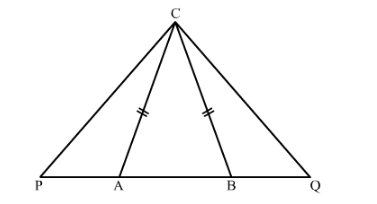In an isosceles $\triangle \mathrm{ABC}$, the base $\mathrm{AB}$ is produced both the ways to $\mathrm{P}$ and $\mathrm{Q}$ such that $\mathrm{AP} \times \mathrm{BQ}=\mathrm{AC}^{2}$. Prove that $\triangle \mathrm{APC} \sim \triangle \mathrm{BCQ}$.
It is given that $\triangle A B C$ is isosceles and $A P \times B Q=A C^{2}$.

We have to prove that $\triangle A P C \sim \triangle B C Q$.
It is given that $\triangle A B C$ is an isosceles triangle, so $\mathrm{AC}=\mathrm{BC}$.
Now,
$A P \times B Q=A C^{2} \quad$ (Given)
$A P \times B Q=A C \times A C$
$\Rightarrow \frac{A P}{A C}=\frac{A C}{B Q}$
$\Rightarrow \mathrm{APAC}=\mathrm{BCBQ}$
Also,
$\angle \mathrm{CAB}=\angle \mathrm{CBA}$ Equal sides have equal angles opposite to them $\Rightarrow 180^{\circ}-\angle \mathrm{CAP}=180^{\circ}-\angle \mathrm{CBQ} \Rightarrow \angle \mathrm{CAP}=\angle \mathrm{CBQ}$
Hence, $\triangle A P C \sim \triangle B C Q$ (SAS Similarity)
Click here to get exam-ready with eSaral
For making your preparation journey smoother of JEE, NEET and Class 8 to 10, grab our app now.
